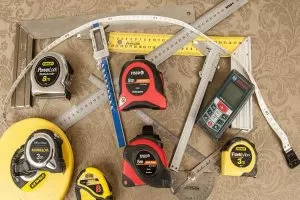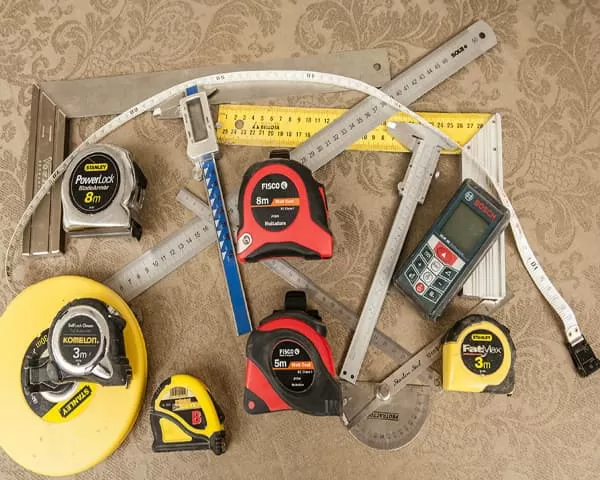The tape measure consists of a steel tape or tape with linear distance measurement marks. The tape remains rigid when extended for measurement purposes but flexible enough to retract into the housing when not in use. The tape casing is generally square in shape and is made of metal or plastic. Few carpenters, bricklayers, plumbers or other traders could do without a tape measure.
Types of Tape Measures
Foldable Tape Measure
A Foldable Tape Measures consists of multiple pivoting sections that are deployed and secured in place to form a rigid ruler for length measurements. A typical folding rule is 6 to 8 feet long when extended. When not in use, sections are folded together in a compact package that is normally approximately 6″ long. A folding rule is also known as a carpenter’s bend rule, bricklayer’s rule, or zigzag rule. The rulers are available with metric or English Marks, sometimes with both.
Laser Tape Measure
The Laser Tape Measures is the perfect solution for professionals and enthusiasts. It is compact, lightweight and economical. It has a single easy-to-use button, used to take single or continuous measurements: the range is from 15 cm to 15 m, with an accuracy of ± 3 mm. It takes measurements in millimeters and inches, and the housing ensures maximum protection of the tool and a safe and comfortable grip. We can also purchase it with batteries included.
Digital Tape Measure
We believe in making measurement simpler, more reliable and more accurate. The original measuring tape has been in continuous production since 1868, but has remained essentially unchanged until the recent introduction to the market The Digital Tape Measures. Tape measure has been a sustainable product because it is an absolute necessity for virtually anyone regardless of their profession. Everyone measures it!
Measuring Tape with Laser Level
This tool combines a tape measure, a three-position bubble level and a laser level into one tool.
The tape measure comes in several presentations in feet that include imperial and metric linear measurements, with graduations up to 1/32″ and 1 mm. Use this multi-purpose laser level to hang images, install shelves, lay the floor, hang wallpaper, and more. Laser level image hanging, self-leveling, construction.
Tape Measures with Magnet
In the case of the Tape Measures with magnet or Magnetic Tip, the end of the magnetic hook adheres to any metal surface, which allows the extension of the tape. The magnetic end of the hook adheres to any metal surface. Attach it to a metal door frame and you can walk to extend the Tape Measures. Ideal for work on low ceilings, steel structures, and tent work.
Tape Measure Adhesive or Self-adhesive
Measuring tapes with adhesive are indispensable in any workshop. In addition to normal machine applications, it may be convenient to apply one to the top of the workbench because you always know where they are. For occasional use, plastic tapes are suitable. But in stores that have a lot of use, steel bands are worth the extra money. Black figures on a yellow field make it easy to read these flexible plastic measuring tapes with adhesive backing.
Tape Measure Brands
Acorn
- Short ribbon of 5 m of chrome.
- Ribbon 25 mm wide.
- Marked on both sides of the tape.
- Hook with 3 additional rivets.
- Bottom block button.
- Special chrome ribbon, long life and maximum strength, high resistance to torsion.
- Steel tape covered with matt varnish or nylon, maximum durability and tape easier to read.
- Absorption of retraction of the tape, to prevent the hook from being damaged.
- Clip to attach the belt to a belt.
Stanley
13-foot tape measure.
- 13 feet standard grip – More direct reach than ever.
- Compact case design: less volume and a comfortable grip, easier to hold and takes up less space on the tool belt.
- 2x more BladeArmor® sheathing 6 inches of BladeArmor® reinforcement to help reduce hook breakage.
- MAXSHIELD blade coating ™: the longest-lasting blade coating applied to a FATMAX tape measure Survives 50 feet deep – Built to last.
- Patented TWIN-CORE ™ technology: Advanced internal double return spring allows a reduced tape size that retains strength and maximum performance.
- Easy to use locking : engages and disengages easily and stays strong when locked.
- Improved and stronger strap clip – New screwless belt clip design allows for easy attachment and removal.
Milwaukee
- 8 m / 26′ magnetic tape.
- Milwaukee® Magnetic Tape is nothing more than Heavy Duty®.
- With nylon blade protection and a reinforced 5-point frame, they offer up to 10 times longer blade life by resisting wear from contamination and increasing protection when dropped.
- To increase productivity on the job site, Milwaukee® magnetic tapes
- They feature a new double magnet system, which attaches securely to the EMT poles from below and with steel bolts at the front. An additional innovative feature is Finger Stop, which protects your finger when the blade is retracted.
Tacklife
Tape measure with 20 meters
Width 15 mm, with zero point, double-sided measuring scale, more comfortable and precise length, for a good measuring sensation.
Accessory design – technical plastic ring; simple measurement; easy to fix at one point; quick recovery; easy and convenient.
Material – Folding band made of fiberglass; restores its shape immediately; ABS + TPR; made of durable, impact-resistant plastic; longer life; lasts a lifetime.
Exterior material – beautiful appearance; brown-black design; compact and functional design; suitable for professional and private use; for smoother and more effective work. The perfect tool for your team
How to Make a Home Tape Measures ?
Here we show you how to make a Tape Measures at home with a school ruler of 30 centimeters a cord tape and fine point markers preferably follow these steps and you will like the result:
Step 1
Spread the white cords on a flat surface, like a table.
Step 2
Measure 3 meters of tape by placing a 30 centimeter ruler next to the tape. Mark the first 30 centimeters with your finger and move the ruler down to measure another 30 centimeters.
Continue this process a total of 10 times. When you reach 3 meters, cut the tape with sharp scissors.
Step 3
Place the freshly cut ribbon on a flat surface. Place heavy books near the center and ends of the tape to help straighten it. Let stand for 1 hour.
Stage 4
Remove the books. Place the 30-centimeter ruler next to the tape. Measure 1 millimeter with the ruler. Use a black marker to mark the millimeter by drawing a vertical line on the tape.
Move the ruler down the tape and mark each of the millimeters with the black marker until you reach 3 meters.
Step 5
Allow the tape measure to dry for 1 hour. Roll up the tape measure and save it for future use.
What are Tape Measures Used For ?
Measuring things like wall length, window frames and even small spaces can be extremely difficult without a tape measure.
In fact, there’s nothing better to get the right measurement than having a tape measure on hand.
These tools are ideal because they have many different measurements, all in the same tape measure. These tape measures are common, but having the right one can make all the difference.
Parts of a Tape Measure
The Spring and the Stop
- A tape measure is retracted because the tape is connected to a flat metal spring wound around a central pole inside the tape casing.
- If the tape is damaged, you can completely remove it from the casing, unhook it from the spring and attach a new tape, provided that you take proper precautions to prevent the spring from retracting.
- Almost all tape measures have a locking button to keep the tape extended; the operation of this button is very simple. It simply locks against the tape to prevent it from moving when you hook it.
The Housing and Belt Clip
- The casing, which can be made of metal or plastic, serves the essential function of containing the belt and spring and preventing them from unrolling. It has a flat bottom with a length that is carefully measured and displayed so that you can include it in your measurements.
- For example, if you are measuring the inside distance between two walls, you would hold the end of the tape against one wall and the end of the tape casing against the other and add the length of the tape casing to the tape measurement.
- The casing often includes a belt clip, which is an essential feature for anyone using a tape measure in the field.
The Stop Tab
- At the end of each tape measure is a metal tab that performs the important function of preventing the tape from disappearing into the casing, but that’s not all.
- When you need to make an external measurement, you can hook the tab over an edge to stretch the tape. If you are making an internal measurement, the slack adjusting tab slides onto the tape, which is calibrated to allow its width.
- It is important to protect the flange when retracting the tape to prevent it from bending.
- the tape casing when you release the stop and let the tab hit your finger instead of the casing.
How to use the Tape Measure ?
You could say it’s a manufacturing defect, but it’s actually a necessary function because the tape measure can be used in two ways:
The first way is to support the pin against a wall. In this case, the tape measure includes the thickness of the steel hook.
The second way is to hold the tape measure using the spout. In this case, the measure no longer includes the thickness of the steel pin, that difference is compensated by the displacement of the pin. This is the reason for the slack in the tang of the tape.
5 Meter Tape Measure
- The tape is the actual working part of a tape measure, it is essentially a rolled flexible ruler.
- The total length of the tape determines the range of measurements it can make; for example, a 5 meter tape is suitable for measuring cabinets or small jobs for interiors as well as windows, doors, dining rooms.
8 Meter Tape Measure
- An 8 metre tape is a better tool for owners and builders outdoors. On the tape measure, each number corresponds to one inch with each inch subdivided into 1/16 or 1/32 inch, depending on the accuracy of the tool.
- The numbers on a tape measure denote centimeters, and the spaces between the numbers are graded in millimeters. Some tapes show inches and centimeters
50 Meter Tape Measure
- The Metric Tape of 50 Meters consists of a tape graduated in meters, decimeters, centimeters and millimeters, with a length that can reach the 50 meters and constituted by the most diverse materials.
- The modern models usually come in a support with a reinforced and wide grip, which allows us to tighten the tape with force through a large crank.
How to Calibrate a Tape Measure ?
The following procedure is used to measure the traces of the flexible ruler or Tape Measure.
- The calibration will be carried out by taking the measurement of a single trace: always in a growing sense by taking a point according to our needs, or by acting as a Tape Measure.
- so that for flexible rulers up to 5 m at least 5 points are calibrated, and for flexible rulers over 10 m at least one or two points per metre.
- The 0 stroke or origin of the scale is made up to the mark: taking this mark as reference, it is moved and with the help of the magnifying glass they are directed to the following calibration points, proceeding again to the mark, obtaining in all cases the distance from the 0 stroke or origin to each one of the calibration points.
- For flexible rules with a measuring range greater than the range of the measuring machine used, calibration will be carried out in sections, considering as the starting point of each section the end point of the previous section.
History and Evolution of the Tape Measure
Despite widespread use, tape measure is a relatively new tool. It was unheard of before the 1830s.
The first written mention of a coated tape measure was in 1838, in England, when a certain Charles White was sentenced to the penal colony in Australia for stealing a tape measure rolled from a metal box.
The ancient Romans measured with a marked leather strip. But when we think of a tape measure today, we think of a tape made of metal or cloth marked in increments – inches and feet or centimeters and meters – rolled up in its own storage box. To measure, the tape is taken out of the box.
A spring or crank puts the tape back in the box, ready for the next use. What we know today as a tape measure (case, metal or cloth tape, and spring or crank return) was invented between 1830 and 1880.
Two types of tape measures were produced: long measures and pocket measures. Long tape measures were divided into two types. Tape measures of 25, 50, 75, or 100 feet in length were called engineer tape measures, which are used in the construction of bridges, dams, and buildings.
The 16-1/2, 33, and 66-foot long tapes were known as the topographer tapes and were used in measuring the earth. The 16-1/2-foot-long rod was used to measure the ground. Therefore, 16-1/2 feet or increments of that number, sets the length of the surveyor’s tape.
Related Topics

💚 WOODWORKING MANDREL: Brands, Types and Prices
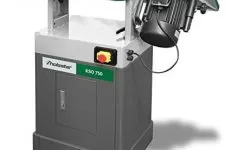
BELT SANDER for Metal, Floors and Knife Sharpening. Brands
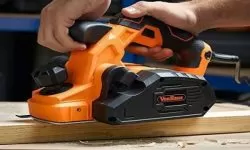
PLANER TOOL: Definition, Uses, Brands and Types
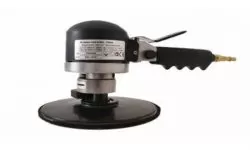
ORBITAL SANDER: Models and Brands like Dewalt, Bosch and Makita

ANGLE GRINDER: Types, Prices ans Brands as Makita and Bosch

PNEUMATIC SANDER for Metal, With Vacuum. Its Prices and Brands
Other Topics of Interest in ALPHAPEDIA

FREE SHOOTING COURSE

FREE MBA COURSE

FREE BANK TELLER COURSE

FREE PHYSICS COURSE

💚 WHAT IS THE OMEGA 3 GOOD FOR ? Benefits and Properties

FREE MASTER DEGREE IN ASTRONOMY
Tape Measure Images
